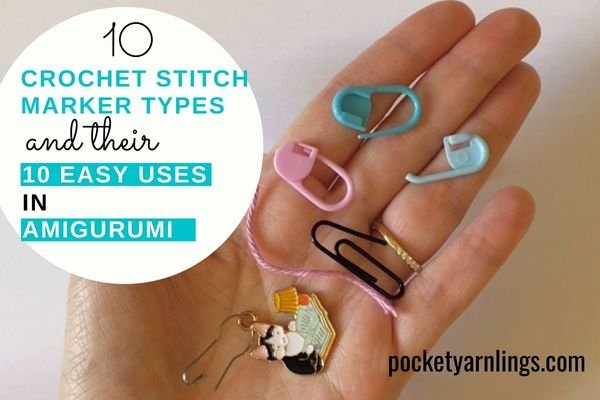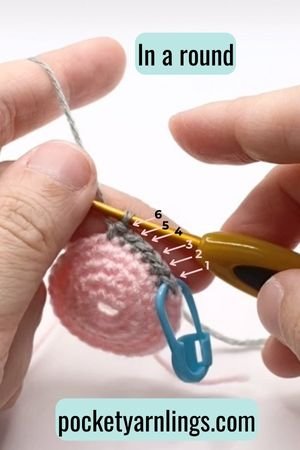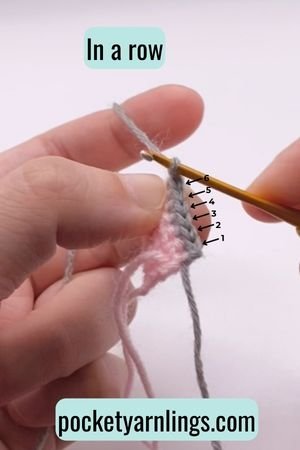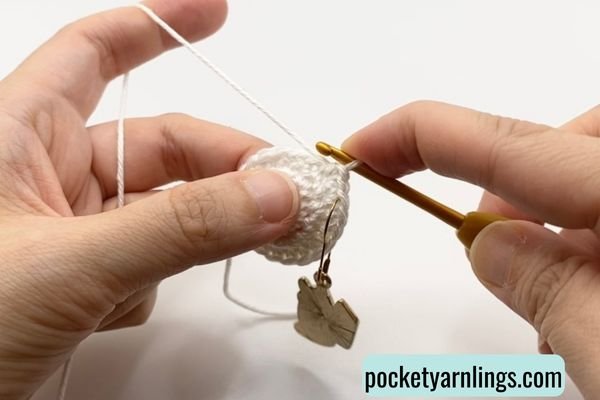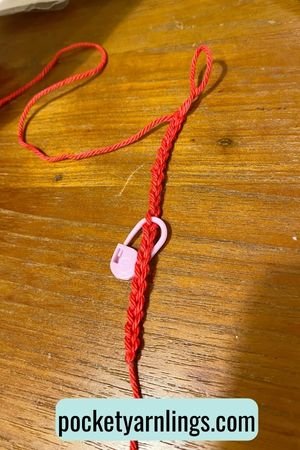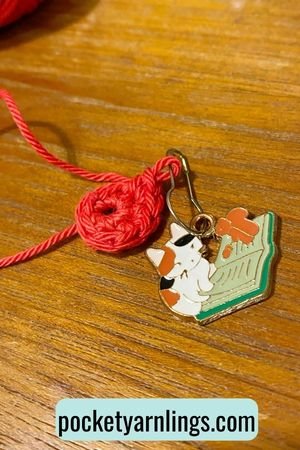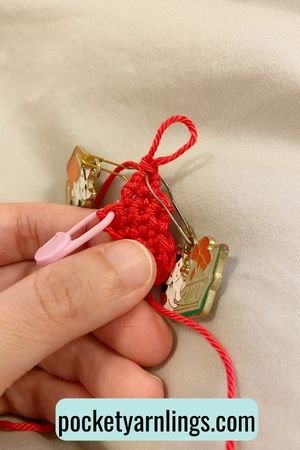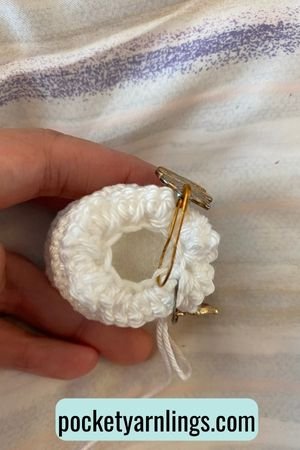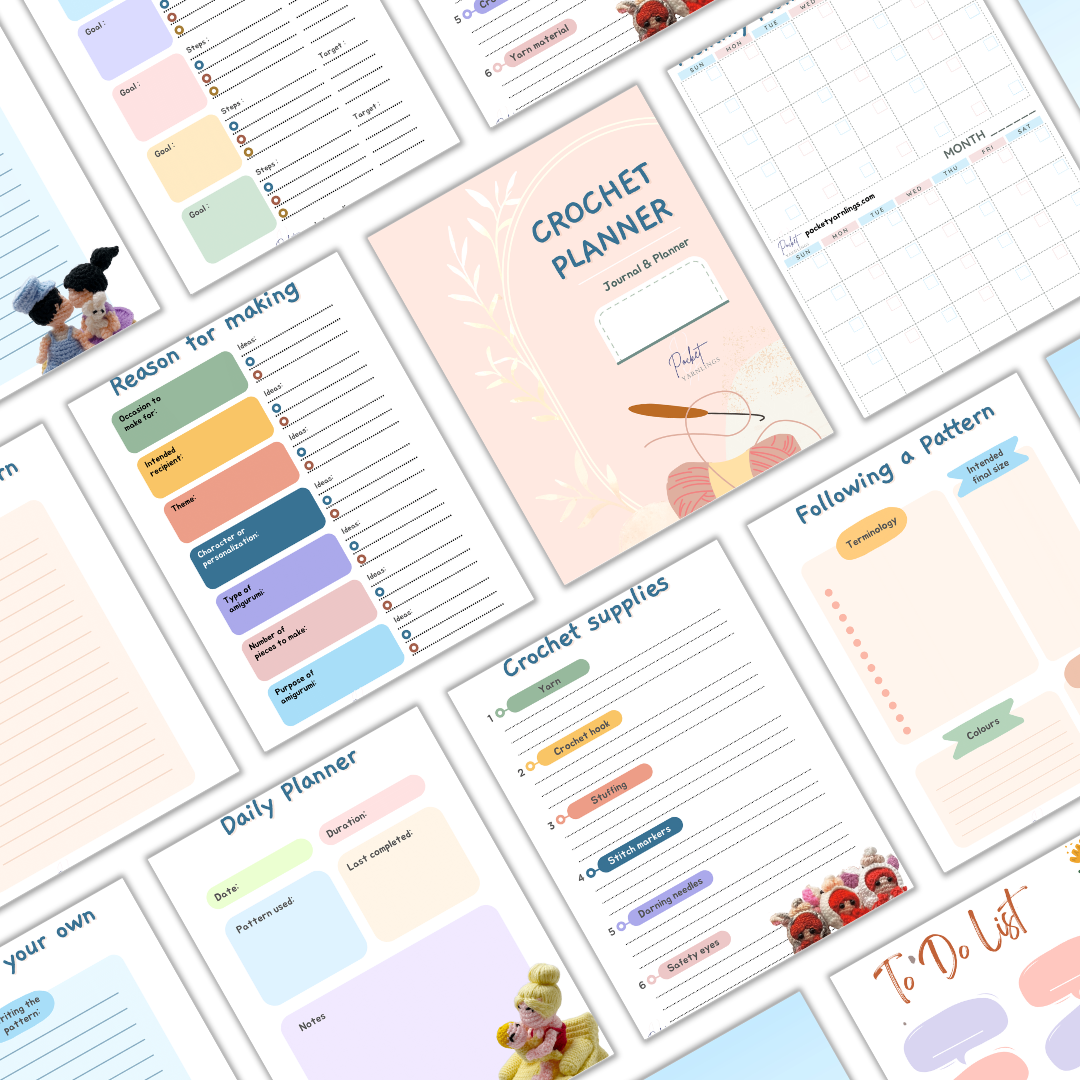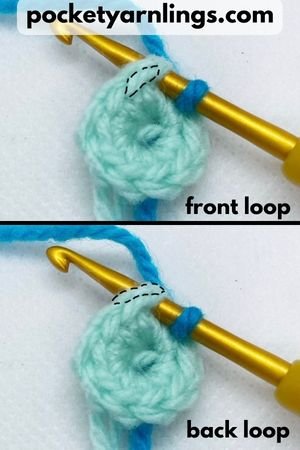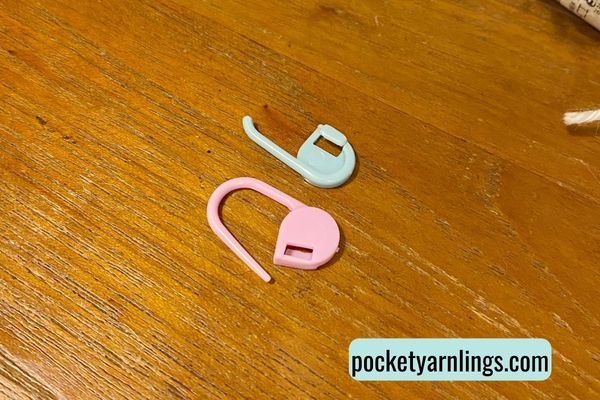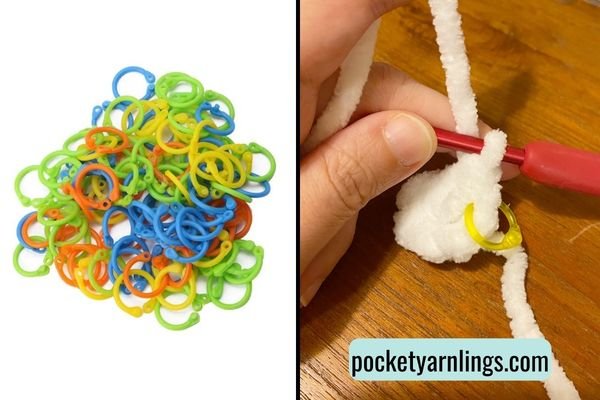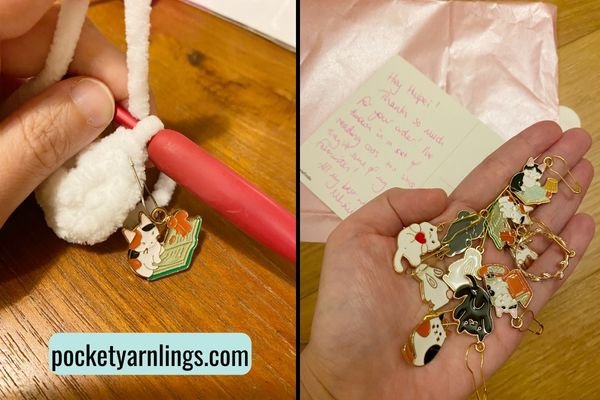10 Crochet Stitch Marker Types and their 10 easy Uses in Amigurumi
If you are struggling with counting your stitches when you are crocheting, then this guide will help you! Just to start off, let us review some basic foundational skills like how to count stitches when crocheting. Then we will move onto how using crochet stitch markers can help you keep count of your crochet project, and in particular for amigurumi!
Table of Contents Show
How do you count stitches when crocheting?
Counting stitches is important in crochet because you want to keep track of how many stitches you have made in a round. Even though it can be forgiving (meaning missing 1 or 2 stitches might not be super obvious in the final product), it can affect the way you follow a crochet pattern because the counts in the subsequent steps will not tally! Here we will briefly go through how to count the crochet stitches in a round, in a row and when crocheting a chain.
How to count crochet stitches in the round?
When counting the stitches in a round, you could refer to the front and back loops as a single stitch. If you are crocheting in different colours like the example here, you could even refer to the 'V'-shaped stitch in the round below to count stitches, but this can get confusing with increases and decreases in stitches.
It is easy to to lose count of your stitches when working in a round, which is why I would recommend adding stitch markers, like I did here. There are many ways to use stitch markers as you will see later on, but the idea is to demarcate the start of the round, so that when you finish the round, you know to readjust the marker for the start of the next round.
How do I count my stitches in a row?
Counting in row can be easier than counting the chains or in rounds. This happens because there is a clear demarcation to the end of the row, as opposed to in a round. Similar to counting in a round, use the FLO and BLO to count as one single stitch. Do note if you have a chain and a turn at the end, it is not counted into the row count. Here the colour demarcation is for easier reference.
How do you count stitches when crocheting a chain?
This is the most basic form of counting, the number of chains starting off in the foundation before crocheting in rows. It can be confusing at times if you are just starting off crocheting, but once you get the hang of it, it gets easier. Look out for the 'V'-shape for each chain to count the chains.
After the initial chain in the first row for most crochet patterns, sometimes in the second row, it will continue with 'crochet into second chain from hook' which just refers to the chain just adjacent to the hook. Also oftentimes, in many crochet patterns, the chain part of a row might not be included in the final stitch count of the row.
As you can see from the above, counting stitches can be quite daunting if you cannot keep track and if you lose count, wow you could really start from the beginning again. (I am that particular, sometimes if I count one wrongly, I undo that round and the preceding round, or even all the way to the beginning if I want to make sure the crochet pattern I designed is correct!)
What is a stitch marker?
A stitch marker is a small little round item, made either from plastic or metal, that is inserted into your crochet (or knitting actually) project to mark a certain important location. It can be something that you intentionally bought for stitch marking purposes or something that you DIY whipped up from other regular stationary items.
What does a stitch marker do?
A stitch marker is inserted into a desired location to make a specific landmark on your crochet project, which might be important to you later on when you are crocheting. It could be used to keep count of the number of stitches or simply a way to keep track of where you were, for when you get back to your project after stopping for a while. For specific reasons why you would need a stitch marker, see the next parts below.
Do you need a stitch marker for crochet?
When crocheting in rounds, rows or chains like I mentioned above, you could crochet without any landmarks if you make a mental note of counting. There are some crocheters who do not like to use stitch markers because it sometimes creates a bigger stitch hole where it was inserted, as compared to the other regular stitches.
Some would use a stitch counter like the one below here to keep score of the number of stitches crocheted. For example if you are working a big round like 72 stitches in a round, every 10 stitches you work on, you could pause and increase the stitch count number by 10. Not something I would prefer, even though I have done this before because I find it quite disruptive to crocheting and definitely no Netflix while crocheting then!
Why do you need a stitch marker?
Crocheters use stitch markers in a variety of ways, in whichever situation where it makes the crocheting project easier to do. Here I am talking about 10 ways to use stitch markers for crochet projects, with some specifically for amigurumi which tend to be worked in rounds.
What are stitch markers used for in crochet in general?
Start of round
Most common use for stitch markers would be to keep track of the start of the round, meaning insert the stitch marker into the first stitch of the round. Once the round is completed and you want to move onto the second round, then you remove the stitch marker and place it at the first stitch of the second round and so on.
Pattern repeats
It can be used to keep count of stitches in a round or row, when there are pattern repeats or sometimes large amigurumi rounds or when making garments.
Right side of rows
When crocheting in rows, stitch markers can be used to mark up the right side from wrong side by placing it in the starting stitch of the right rows.
Counting chains
If you are crocheting long chains then also consider marking every 10 chains made with one stitch marker, so you don't lose count of the whole chain.
Stop project from unravelling
This is really useful for when you decide to put down your project and get back to it later. Just place the stitch marker into the last loop made to stop it from unraveling and take it out when you are ready to resume.
How do you keep track of stitches in amigurumi?
The next few tips are specific situations I've used stitch markers for amigurumi so hopefully these give you some ideas on how they are useful.
Plan placements
To landmark placements like eyes or limbs in amigurumi, instead of using pins you could try using stitch markers, especially for bigger amigurumis. Do note it may sometimes cause some distortion of the stitches.
Landmark a round transition to a row
This situation arose because I was working in a round and then the pattern I designed needed a transition to a row. To divide a preceding round from a subsequent I used a stitch marker to keep track. This was pretty useful when doing pattern designing.
Make small stitches obvious
When crocheting decreasing rows like making a triangle, to keep the last unworked small stitches in a row obvious, I left stitch markers in them. This was useful when working up and down the triangle subsequently.
Differentiate front from back loops
This is a tactic I use for when I'm surface crocheting separately into front and back loops. For example, if you work into the BLO to make the legs, then you want to surface crochet into the FLO to make clothes then the front loops can sometimes be difficult to find. This is where I place the stitch marker.
Splitting big rounds into smaller rounds
When crocheting a large round and breaking it up into 2 rounds, the stitches can get confusing so place one stitch marker for the big round and then another 2 for the smaller rounds. Similarly for combining 2 small rounds into a large round, using a stitch marker for all 3 rounds can help with the stitch count confusion.
Free Crochet Planner Journal!
Click here to grab this 20-paged workbook and checklists that will help organize your creativity before you even start on your next crochet project! Or click on image on the left.
What does a crochet stitch marker look like?
As you will see later on when I talk about the best stitch markers, they can have different appearances. One thing they have in common is that they have a component to insert into the stitch to be marked, and another locking component so the marker does not fall out.
Where do you put a stitch marker in crochet?
If you are also wondering how do you attach stitch markers, the free end is inserted into the desired stitch location, it could be into both loops, or it could be front loops or back loops only. Or it could be inserted into a chain or a unworked loop, depending on what you need help with in your crochet project.
How many stitch markers do I need?
Definitely have a couple handy because one is usually not enough. If you need it for multiple repeats in pattern sets or rows or when combining rounds then maybe 3-4 are needed. As you will see later on as well, some are more prone to breaking so having extra handy is useful. Probably at least 5 or a bunch of them.
What can I use if I don't have stitch markers?
Before we move onto the type of stitch markers available, if you are just starting out and don't want to invest in too much crochet equipment, some common stationary can be used as stitch markers!
Can you use a paperclip as a stitch marker?
This is probably the easiest to get hold off and was what I started off with. The biggest issue was that the wire from the paper clip kept catching on the yarn and causing it to fray. Which was why I moved onto proper stitch markers.
Can you use bobby pins as stitch markers?
Another easy hair accessory to get hold off is bobby pins. Similar issue to paper clips is that it catches on the yarn. Another problem is that there is no locking mechanism which means sometimes after stitch marking, the whole pin might fall out and pull the yarn along with it.
Can I use safety pins as stitch markers?
Compared to the other 2 earlier make shift options, this is probably the best. As you will see later on, it is similar to the commercial metal stitch markers. It does not catch on the yarn so easily because of the pointy end and there is a locking mechanism. Only thing is that you might poke yourself using it!
How do you use yarn as a stitch marker in crochet?
Another popular option that is cost effective since you will be recycling is to use stray leftover yarn to string through the intended stitch to be marked. Use a darning needle to string through the intended location to mark it. You could even string through consecutive rounds in the same first stitch. I don't use this method because I have frequent entanglement with multiple yarn colours so adding on the stray yarn did not work out well.
Pin this image below and share this article if you found it useful!
What are the best crochet stitch markers?
With all the background I mentioned above, here is the part where I talk about the different stitch marker options on the market. I use a combination of them whenever I feel in the mood so feel free to try them too!
Plastic crochet stitch markers
Many serious crocheters start off with plastic crochet stitch markers because it is readily available and not super expensive. There are a few different types as listed below.
Plastic safety pin
This is a plastic version of a safety pin shape, an oval shape with a locking mechanism. Most popular plastic option but most common problem I face with this is that it breaks relatively easily! Especially if you crochet fast and pull the stitch markers in and out in a hurry, the insertion part can snap.
Split stitch ring
Another name to call it would be a slide-in stitch marker. It has a round shape, use the pointed end to slide into the desired stitch location and keep it inside the middle hole. I tried using this once or twice and I did have the marker slide out of the stitch because of a lack of locking function.
Locking ring
This ring is similar to the previous split stitch ring version but it does have an additional locking mechanism, which means it is less likely to slip out. It also does not break as easily as the plastic safety pin markers. However, the reason why I don't use it often is because it does not slide in and out of the stitch as easily and smoothly as the safety pins ones, which sometimes slows down the crocheting process.
Metallic crochet stitch markers
Of late I have taken to using metallic crochet stitch markers more frequently partly because of the pretty accessories that can come with it, as you can see later on.
Metal light bulb
This was what I meant when I mentioned these crochet stitch markers are quite similar to safety pins, except that the shape looks more like a light bulb rather than just an oval. This helps with facilitating more space for the stitch to slide through after insertion. I like the pretty attachments that can come with this type of stitch marker although they can drop out and be a distraction. The sharp pointy ends means that it slides easily into stitches without getting caught in yarn but be careful not to poke yourself!
Lobster clasp
This is not something that I have personally tried so I'm not sure how ergonomic it is but it is quite popular amongst crocheters because like the previous example, you can accessorize and it does have a locking mechanism. I suppose you will also be less likely to accidentally poke yourself since it is not sharp so it is on the list of things for me to try out!
Conclusion
So there you have it, all the different types of stitch markers. Now you know why using them is helpful in counting stitches. You can also use simple everyday stationary like paper clips, bobby pins and safety pins to double up as crochet stitch markers. When you are ready to buy some good ones especially after getting serious about crocheting, invest in some plastic or metallic ones, there are many choices!
Also to get ready for your first or next crochet project, how about grabbing a free planner than has checklists on what you need to plan and supplies you need to gather before starting?
Free Crochet Planner Journal!
Click here to grab this 20-paged workbook and checklists that will help organize your creativity before you even start on your next crochet project! Or click on image on the left.


